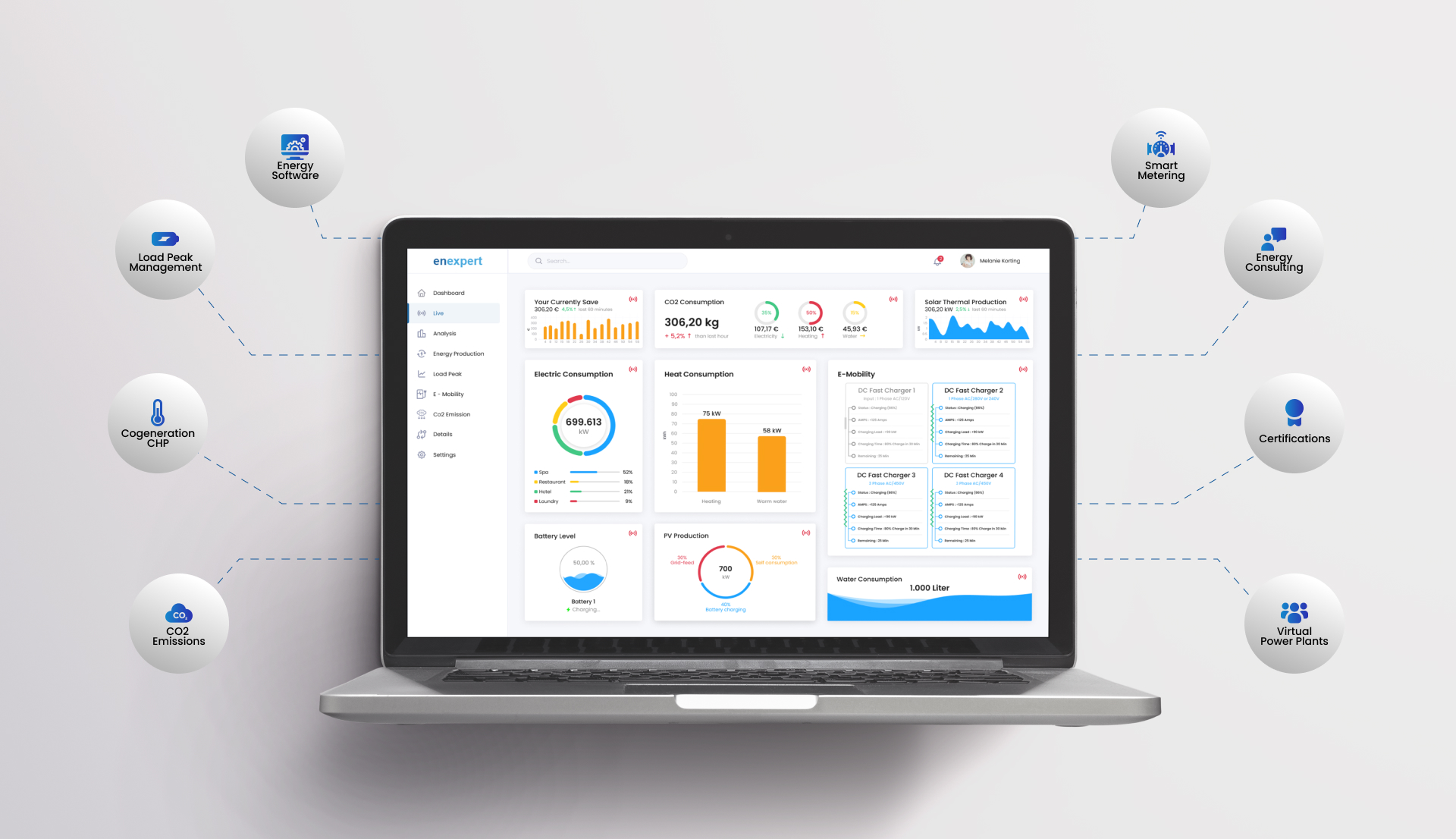
Our services
Discover what we have to offer!
Energy software
Consumption pattern recognition - Weather forecasts - Energy optimisation - Community batteries
What is energy software?
What does EnExpert offer?
Energy consumption monitoring
Our energy software collects energy consumption data from various sources, including electricity, gas and water meters, to monitor energy consumption in real time.
Energy analysis
The software analyses the collected data and generates reports to identify trends and patterns in energy consumption
Energy management
Based on the results of our energy software, companies can achieve energy savings by optimising energy consumption and use. Energy efficiency projects can also be planned, implemented and tracked using the software.
Carbon footprint monitoring
The software also helps measure and track a company's carbon footprint by monitoring energy consumption and emissions data
Management of renewable Energies
The energy software can also help integrate renewable energy sources such as solar or wind energy into a company's energy portfolio and maximise the use of these resources by cross-referencing production data with weather forecasts and prices on the energy market.
Energy consulting
PV, CHP & Battery Planning - Energy Simulation - Energy Self-Sufficiency - Energy Monitoring
What is an energy consultation?
What does EnExpert offer?
Initial contact
Here we go into detail about the specifics and long-term goals of the company
Inventory assessment
This involves recording the existing energy consumers, e.g. lighting, heating and air conditioning, as well as the energy consumption of the production processes and the building envelope.
Analysis
The analysis of the data is necessary to identify possible savings potential and optimisation opportunities. Operational procedures, work processes and user behaviour are also taken into account.
Action plan
Based on the results of the analysis, a catalogue of measures is drawn up that contains concrete proposals for optimising energy efficiency. Both technical measures and organisational measures are taken into account.
Realisation
The measures are implemented in close coordination with the company.
Monitoring
After the implementation of the measures, the energy consumption is monitored in order to measure and evaluate the efficiency gains. If desired, we can continue to support the company in this process.
CO2 carbon footprint
CO2 balance - climate neutral company - CO2 compensation
What is a climate-neutral company?
What does EnExpert offer?
As EnExpert, we accompany you on your way to becoming a climate-neutral company. Our approach is as follows:
Quantification
First, we record all direct and indirect greenhouse gas emissions to quantify the carbon footprint. For this purpose, historical data is also used and a forecast of future emissions is calculated.
Action plan
We then help to find and implement suitable measures to reduce emissions. Together, we draw up an action plan to ensure that these measures are implemented efficiently. We also provide support with communication and marketing activities on the subject of the carbon footprint.
Examples of measures
Examples of measures include the use of renewable energies, improving the energy efficiency of buildings and facilities, reducing transport emissions by using public transport or promoting home office arrangements, reducing waste and using environmentally friendly products and materials
Offset certificates
For the remaining amount of CO2 emissions that cannot be avoided, we help to find trustworthy and suitable compensation certificates. These help to reduce or avoid CO2 emissions elsewhere, such as through the construction of renewable energy plants or the reforestation of forests.
Marketing potential
Our clients are increasingly using the issue for marketing and communication purposes. By raising awareness among end customers, this type of approach can strengthen customer loyalty.
Certifications
ISO 50001 - DIN EN 16247-1 - Energy & Environmental Audit - CO2 Certificates
What are certifications and audits?
An energy audit is a systematic examination of the energy consumption of a company, organisation or building, with the aim of identifying potential savings and recommending energy efficiency measures. In some cases, the energy audit is regulated by law and in certain countries, such as Germany, it is mandatory for companies above a certain size. Exceptions are small and medium-sized enterprises (SMEs) and companies with an ISO 50001 energy management standard certification.
The European standard DIN EN 16247-1 forms the basis for energy audits and defines the requirements for conducting energy audits throughout the EU. It includes a thorough examination of energy consumption, both for buildings and for industrial processes. The aim is to uncover possible savings potential and propose concrete measures to improve energy efficiency.
What does EnExpert offer?
Energy audits and certifications have both environmental and economic benefits for a company. At EnExpert, we help our clients achieve these benefits by offering the following:
Audits
At EnExpert, we offer small and medium-sized companies an uncomplicated and simple way to carry out the energy audit, including an energy report, and use this basis to create a data-based energy concept.
Transparent overview
At the end of our energy audit, a report is prepared with the energy consumption, potential savings and recommendations of possible energy efficiency measures. This gives the company a transparent overview of all energy flows and at the same time allows it to identify and exploit potential savings
Certifications
We offer larger companies, which are subject to the legal obligation of an energy audit, the implementation of an ISO 50001 certification. In this way, even a large company can identify and exploit savings potential, get certified and avoid a mandatory audit.
Energy strategy
With the help of the collected data, we create an energy concept together with the company, including a plan of measures and a cost calculation for future investments.
Quality promise
It goes without saying that we carry out our audits and certifications in accordance with the requirements of DIN EN 16247-1.
Virtual Power Plants & Energy communities
Smart Cities - Energy Communities - Virtual Power Plants - Micro Grids
What is an energy community?
An energy community is a group of people, companies or organisations that jointly produce, use and share renewable energy. Energy communities help to promote the energy transition and democratise the local energy economy. They also help to strengthen the local economy by creating local jobs and keeping the value added in the region. The way they work is as follows:
What does EnExpert offer?
As EnExpert, we help to establish energy communities and to use their benefits properly, such as promoting renewable energy, reducing energy costs, improving energy security and democratising energy supply. There are different models depending on the type of energy produced and the size of the community. For example, some energy communities are limited to only one location, while others can be spread over several locations and regions. The legal form and ownership structure can also vary depending on the model. At EnExpert, we help you find a suitable model and legal form.
In short, we help you from planning to implementation and maintenance of the energy community. Thanks to the installation of our IoT sensors and data processing software, we are able to create intelligent weather and energy price forecasts so that an energy community can score points through sustainability and profitability. For us, the regional component and the sense of community among all participants are particularly important.
Creation
Energy communities usually generate renewable energy, such as solar energy, wind energy or biomass. In addition, these energies are also partly stored in energy storage facilities.
Usage
The generated energy is used by the members of the energy community. Here, intelligent control is very important. Therefore, current electricity prices on the stock exchange and weather models are taken into account.
Distribution
The generated energy is distributed via a local electricity grid operated by the energy community. For this purpose, consumption patterns are calculated so that the electricity produced is used most efficiently among the participants.
Organisation
Energy communities are usually organised and run by the members themselves. Energy communities are mostly associations, cooperatives or limited liability companies.
IoT Smart Metering
IoT Sensors - Smart Metering - Internet of Things - Energy Monitoring
What is IoT Smart Metering?
A smart meter is a measuring device that electronically records energy consumption and wirelessly transmits the data to a central server. Unlike conventional metering systems that have to be read out manually, smart metering enables real-time and accurate monitoring of energy consumption. IoT smart metering is the use of intelligent metering systems to record and monitor the energy consumption of devices, systems and buildings. In the process, the data is collected, stored, processed and analysed using Internet of Things (IoT) technology.
What does EnExpert offer?
By integrating IoT technologies, we collect and analyse the measurement data in your company in real time. Based on this data, decisions can then be made automatically to optimise energy consumption. For example, consumers that consume a particularly large amount of energy can be identified, or potential savings in the control of heating, air conditioning or lighting can be detected. Our in-house IoT sensors focus mainly on measuring electricity consumption. However, our technology allows us to integrate other existing (IoT) sensors into our system, such as gas meters, heaters, water meters, e-charging columns, batteries or PV systems. Our IoT smart metering thus enables efficient and automated monitoring of energy consumption, which can lead to energy and cost savings. It can also help to reduce energy consumption and CO2 emissions and thus contribute to climate protection.
Power
Our IoT sensors measure electricity consumption in real time and are installed at various points in the company so that you can get a detailed overview of consumption and make decisions at the same time.
Gas
With the help of intelligent gas meters, gas consumption can nowadays also be monitored in real time. This is especially important in manufacturing industries in connection with process data, so that energy and process optimisation can take place.
Heat
Heating consumption is an important part of energy management today. We have developed non-invasive and quick-to-install ultrasonic sensors that can measure energy consumption in real time.
Water
For water, we also use ultrasonic sensors to determine the flow in real time and thus provide a simple picture of consumption. The same procedure applies to wastewater and can be used for forecasts for smaller wastewater treatment plants.
Cogeneration - Combined Heat and Power
Heat management - CHP - Power-to-heat - Power-to-X
What is combined heat and power?
Combined heat and power (CHP) is the simultaneous generation of electricity and heat in one plant. In this process, the fuel (e.g. natural gas, biomass or fuel oil) is used to generate electricity and the resulting waste heat is used to heat buildings or for process heat. By using the waste heat for heating, the overall efficiency of the system is increased because the otherwise unused energy is put to good use. A CHP system can achieve efficiencies of up to 90 per cent, whereas conventional, separate generation of electricity and heat only achieves efficiencies of 30 to 60 per cent. Cogeneration is considered a very efficient and environmentally friendly way of generating energy, as it can help save fuel and thus reduce CO2 emissions. Power-to-heat (PtH) is a concept in which electrical energy is converted into heat to meet the energy needs of buildings or industrial plants. This mainly uses electrical energy from renewable energy sources such as wind power or photovoltaics.
What does EnExpert offer?
There are different types of CHP systems, such as gas-fired combined heat and power (CHP) plants, biomass CHP plants or mini CHP plants for smaller businesses. In larger plants, CHP systems can also be operated in combination with other renewable energy sources, such as photovoltaic systems or wind turbines. At EnExpert, we help find the right CHP system for your business, plan sensible combinations and control them intelligently. In addition, we help with the planning of PtH plants and calculate efficient and intelligent control, as power-to-heat and power-to-X can be particularly advantageous when there is a temporary oversupply of electricity due to high electricity generation from renewable sources. Instead of feeding this electricity into the grid and possibly even paying negative electricity prices, it can be used to power heating systems or heat pumps. We help find the right technology for PtH applications, such as heat pumps, electric heaters or storage heaters.
Heat pump
Heat pumps are an increasingly important part of combined heat and power generation, as they are becoming more and more energy efficient, environmentally friendly thanks to low CO2 emissions, versatile and durable. In addition, heat pumps are subsidised by the state in many countries.
Combined heat and power plant
Similar to heat pumps, combined heat and power units (CHP) are very energy-efficient with efficiencies of up to 90% thanks to the use of waste heat. CHP units are ideal especially for companies with a high demand for electricity and heat, as they are also largely independent of price fluctuations.
Power-to-Heat
Power-to-heat is a technology that converts electrical energy into heat and is used for the following applications: integration of renewable energies, heat supply, load management or stabilisation of the electricity grid, industrial generation of process heat and energy storage.
Power-to-X
While power-to-heat is already well developed, power-to-X is receiving more and more attention. Here, renewable energy is converted into chemical or synthetic energy carriers such as hydrogen, methane, ammonia or liquid fuels and used for energy storage, sector coupling, decarbonisation thanks to the flexibility.
Peak load management
Energy optimisation - E-charging station management - Maximising of self-produced energy - PPA & Flexibilities
What is peak load management?
A load peak occurs when a company needs a lot of electricity in a short period of time, for example when several production facilities are operating at the same time. If many companies in a certain area cause high load peaks at the same time, this can lead to bottlenecks in the power grid, which can cause power outages. To avoid such situations, power supply companies often charge their customers an additional fee for peak loads.
To avoid this charge, the company can engage in peak load management by reducing electricity consumption during peak periods. On the one hand, this reduces the energy costs for the company and on the other hand, it relieves the load on the power grid.
What does EnExpert offer?
Peak load management usually sounds simple and logical. However, it requires careful planning and implementation, as it is important that production processes do not suffer as a result of the measures. We at EnExpert help your company with this planning:
Monitoring
We monitor and analyse the energy flows of a building or company and identify consumption patterns and load peaks. Thanks to real-time monitoring, load peaks and the triggers can thus be detected.
Peak load reduction
Afterwards, we support the planning and implementation of various measures and methods that help to reduce peak loads. In addition, our accurate and clear energy measurement allows us to find tailor-made solutions for each company.
Our actions
Some measures and methods we use are: Shifting energy-intensive processes to times when less electricity is consumed; Using combined heat and power plants that generate electricity and heat; Using energy storage systems that cover electricity demand at peak times; Reducing electricity demand through energy efficiency measures; Intelligent control of the production process.
Quality management
Our approach here is not to switch on and off when the connection cap is reached, but the intelligent analysis behind it to understand who is responsible for the load peak and how this can be avoided in the future. Since load peak monitoring is part of our energy management, this issue can be solved in most cases without installing load shedding.







